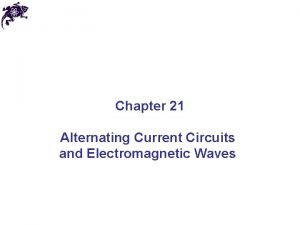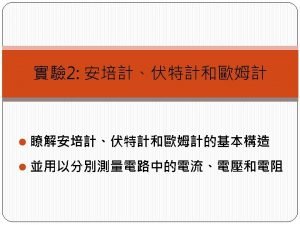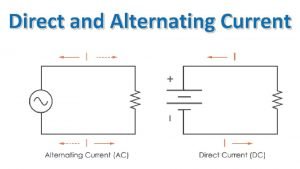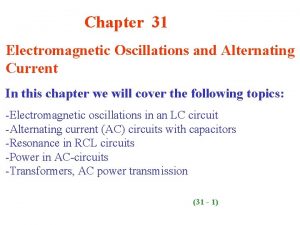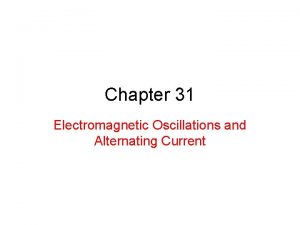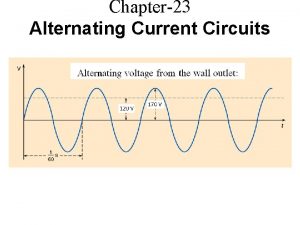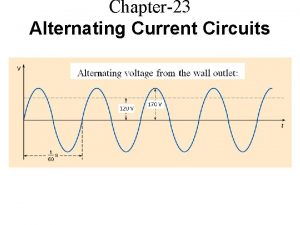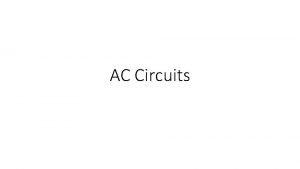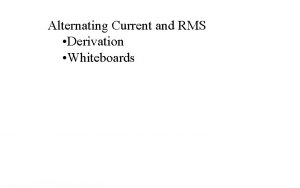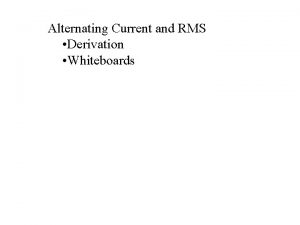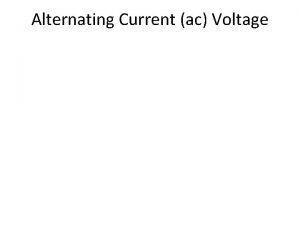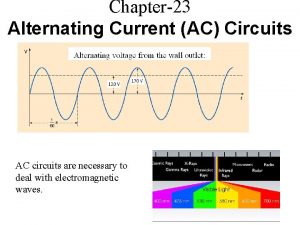DArsonval Meter in Alternating Current Circuits DArsonval Meter













- Slides: 13

D'Arsonval Meter in Alternating Current Circuits D'Arsonval Meter with Half Wave Rectification RS If. s Er. m. s Eav Rm 1

• The constant 2. 22 is called the form factor The series resistance Rs can be calculated as 2

Therefore, the pointer will deflect for a full scale if 10 Vdc is applied and only 4. 5 V when a 10 Vrms sinusoidal signal is applied. The DC voltmeter sensitivity is given by: For the circuit of the AC voltmeter sensitivity is given by: This means that an AC voltmeter is not as sensitive as a DC voltmeter. 3

The total resistance RT can be calculated as where 4

EXAMPLE Calculate the value of the multiplier resistor for a 10 Vrms range on the voltmeter shown in in the following Fig. RS Er. m. s =10 V Solution 5

or The series resistance Rs can also be calculated as 6

RS Ein D 1 D 2 R Rm Half wave rectification using an instrument rectifier and shunt resistor for improved linearity ØD 2 is forward in the negative half-cycle and it is used to provide an alternate path for reverse biased leakage current ØRsh is used to increase the current flow through D 1 during the positive half cycle 7

D'Arsonval Meter with Full Wave Rectification þ þ The full-wave rectifier provide higher sensitivity rating compare to the half-wave rectifier. Bridge type rectifier is the most commonly used Full Wave Bridge Rectifier Used in AC Voltmeter Circuit. 8

Operation; þ (a) During the positive half cycle (red arrow), currents flows through diode D 2, through the meter movement from positive to negative, and through diode D 3. - The polarities in circles on the transformer secondary are for the positive half cycle. - Since current flows through the meter movement on both half cycles, we can expect the deflection of the pointer to be greater than with the half wave cycle. - If the deflection remains the same, the instrument using full 9 wave rectification will have a greater sensitivity. (b) Vise-versa for the negative half cycle (blue arrow).

þ From the circuit in Figure 5. 9, the peak value of the 10 Vrms signal with the half-wave rectifier is, þ The average dc value of the pulsating sine wave is, þ Or can be compute as, þ The AC voltmeter using full-wave rectification has a sensitivity equal to 90% of the dc sensitivity or twice the sensitivity using half-wave rectification. 10

Example. Each diode in the full-wave rectifier circuit has an average forward bias resistance of 50 Ohm and is assumed to have an infinite resistance in the reverse direction. Calculate, (a) The multiplier Rs. (b) The AC sensitivity. (C)The equivalent DC sensitivity. 11 q. AC Voltmeter Using Full-Wave Rectification and Shunt.

Solution: (a) Calculate the current shunt and total current, þ The equivalent DC voltage is, 12

(b) The ac sensitivity, (c. ) The dc sensitivity, 13
 Alternating current circuits and electromagnetic waves
Alternating current circuits and electromagnetic waves D arsonval movement
D arsonval movement Vrms to vpp
Vrms to vpp Alternating current ppt
Alternating current ppt Alternating current
Alternating current Ac current graph
Ac current graph Chapter 7 alternating current
Chapter 7 alternating current Complex parallel circuit
Complex parallel circuit Electromagnetic oscillations and alternating current
Electromagnetic oscillations and alternating current Line regulation
Line regulation Electromagnetic oscillation pdf
Electromagnetic oscillation pdf What is a parallel circuit in physics
What is a parallel circuit in physics Chapter 35 electric circuits answers
Chapter 35 electric circuits answers Balanced delta-delta connection
Balanced delta-delta connection
